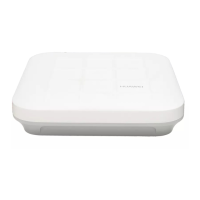For details about WLAN channel management, see the Country Code & Channel Compliance Table.
Automatic channel scanning and interference avoidance
Service set identifier (SSID) hiding
Signal sustain technology (SST)
Unscheduled automatic power save delivery (U-APSD)
Control and Provisioning of Wireless Access Points (CAPWAP) in Fit AP mode
Automatic login in Fit AP mode
Extended Service Set (ESS) in Fit AP mode
Wireless distribution system (WDS) in Fit AP mode
Mesh networking in Fit AP mode
Multi-user CAC
3.2 Network Features
Network features supported by the AP are as follows:
Compliance with IEEE 802.3u
Auto-negotiation of the rate and duplex mode and automatic switchover between the
Media Dependent Interface (MDI) and Media Dependent Interface Crossover (MDI-X)
Compliance with IEEE 802.1q
SSID-based VLAN assignment
VLAN trunk on uplink Ethernet ports
4094 VLAN IDs (1-4094) and a maximum of 16 virtual APs (VAPs) for each radio
AP control channel in tagged and untagged mode
DHCP client, obtaining IP addresses through DHCP
Tunnel data forwarding and direct data forwarding
STA isolation in the same VLAN
Access control lists (ACLs)
Link Layer Discovery Protocol (LLDP)
Uninterrupted service forwarding upon CAPWAP channel disconnection in Fit AP mode
Unified authentication on the AC in Fit AP mode
AC dual-link backup in Fit AP mode
NAT
IPv6 in Fit AP mode
3.3 QoS Features
QoS features supported by the AP are as follows:
Priority mapping and packet scheduling based on a Wi-Fi Multimedia (WMM) profile to
implement priority-based data processing and forwarding
WMM parameter management for each radio

